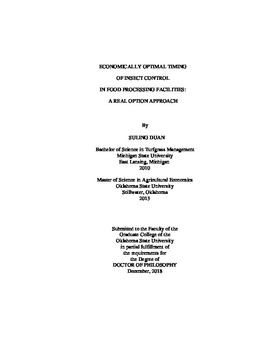| dc.contributor.advisor | Adam, Brian Dale | |
| dc.contributor.author | Duan, Suling | |
| dc.date.accessioned | 2019-07-19T13:33:30Z | |
| dc.date.available | 2019-07-19T13:33:30Z | |
| dc.date.issued | 2018-12-01 | |
| dc.identifier.uri | https://hdl.handle.net/11244/320928 | |
| dc.description.abstract | Insect control is a key concern for handlers of grain and grain-based products during the storage, processing, and packing processes. Insect infestations and insect fragments in food products can cause both direct and indirect economic losses. The most significant economic damage from insects in food processing facilities is contamination of food, which can lead to rejection of shipments, treatment cost, insect fragments in food, consumer complaints and loss of consumer goodwill. However, the potential damage is hard to quantify. The cost is large but the probability of occurrence may be low.Food processors must balance costs of insect control and risks of failing to control insects, while choosing from a set of imperfect insect control methods. An economical insect control strategy must make effective use of available information to optimize the timing of insect control methods, both chemical and non-chemical.In this study, real option models are used to value insect control treatments and pick the optimal timing to treat insects. Daily temperature is the stochastic variable which is the main source that causes uncertainty about insect population and the corresponding potential damage.Results found that the real option approach can reduce costs compared with using an economic threshold approach. The optimal treatment time signaled by a real option approach is earlier if temperatures are expected to increase, due to the higher probability of damage. Conversely, the optimal treatment time is likely to be later if temperatures are expected to decrease. Thus, the real option approach, by taking into account probabilities of future temperature movements, can reduce treatment cost by postponing treatment if temperature is likely to decrease, and can reduce insect damage loss by accelerating treatment if temperature is likely to increase. | |
| dc.format | application/pdf | |
| dc.language | en_US | |
| dc.rights | Copyright is held by the author who has granted the Oklahoma State University Library the non-exclusive right to share this material in its institutional repository. Contact Digital Library Services at lib-dls@okstate.edu or 405-744-9161 for the permission policy on the use, reproduction or distribution of this material. | |
| dc.title | Economically Optimal Timing of Insect Control in Food Processing Facilities: A Real Option Approach | |
| dc.contributor.committeeMember | Brorsen, B. Wade | |
| dc.contributor.committeeMember | Whitacre, Brian | |
| dc.contributor.committeeMember | Yan, Shu | |
| osu.filename | Duan_okstate_0664D_13593.pdf | |
| osu.accesstype | Open Access | |
| dc.description.department | Agricultural Economics | |
| dc.type.genre | Dissertation | |
| dc.type.material | Text | |
